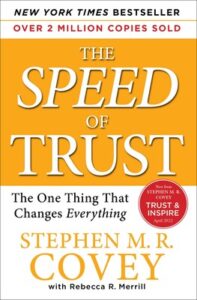Behavior #3: Create Transparency, page 152.
Summary: Behavior #3 – Create Transparency
- Tell the truth in a way people can verify.
- Be genuine.
- Be open and authentic.
- Err on the side of disclosure.
- Operate on the premise of “What you see is what you get.”
- Don’t have hidden agendas.
- Don’t hide information.
Behavior #3 Create Transparency
- Creating Transparency is about being open.
- It is about being genuine and telling the truth in a way people can verify.
- It’s based on the principles of honesty, openness, integrity, and authenticity.
- It cleanses. It dissipates the shadows. It casts out the darkness. It enables people to see. It gives them a sense of comfort and confidence because they know nothing is being hidden.
- The opposite of Create Transparency is to hide, cover, or obscure. It includes hidden agendas, hidden meanings, and hidden objectives.
- The counterfeit of transparency is an illusion. It’s pretending, “seeming” rather than “being,” making things appear different than they are.
Building Trust Fast
- More and more in our global economy, transparency is gaining recognition as a critical value in high-trust organizations.
- Transparency will usually establish trust fast.
- Particularly when trust is low, people don’t trust what they can’t see. By opening things up, you assure people there’s nothing to hide.
- From the standpoint of speed and cost, transparency makes enormous sense. You don’t have to worry about hidden agendas. You don’t have to second-guess. You don’t have to waste time and energy trying to maintain an appearance. You don’t have to keep up with which approach you took with which person.
- Many companies create transparency with their employees using what is known as “Open Book Management” – opening up their financial statements for the entire company to see.
- Creating transparency also creates buy-in.
Trust Tips
- In Create Transparency, as in all of the behaviors, there must be responsible balance. Good, common sense would tell you that you don’t talk about confidential matters, private conversations, or other things you don’t have a right to talk about.
- Irresponsible transparency, unbalanced by other behaviors such as Demonstrate Respect, can create too much transparency too quickly and can shock the system.
- Most often, Irresponsible transparency comes from a lack of one or more of the following:
- Humility (Integrity)
- Mutual Benefit Agenda (Intent)
- Trust Abilities and Leadership Skills (Capabilities)
- Appropriate Definition of and Sensitivity to Outcomes (Results)
- On the other end of the spectrum, though, why would you limit appropriate transparency? Why would you withhold information? Why would you not put all of your objectives on the table?
- Failure to create transparency usually indicates a lack of honesty or courage (Intent), a hidden rather than open agenda (Intent), or a lack of Trust Ability to discern the importance of transparency and create it (Capabilities).
Improving Your Ability to Create Transparency
- Ask yourself, “Am I withholding information that should be shared? If so, why?” Think about the tax you may be paying as a result.
- If you’re in a position of leadership at work, rate the transparency of your organization with regard to your various stakeholders. Ask yourself, if I was more transparent, what difference would it make? Look for ways to appropriately increase transparency – and trust dividends!



